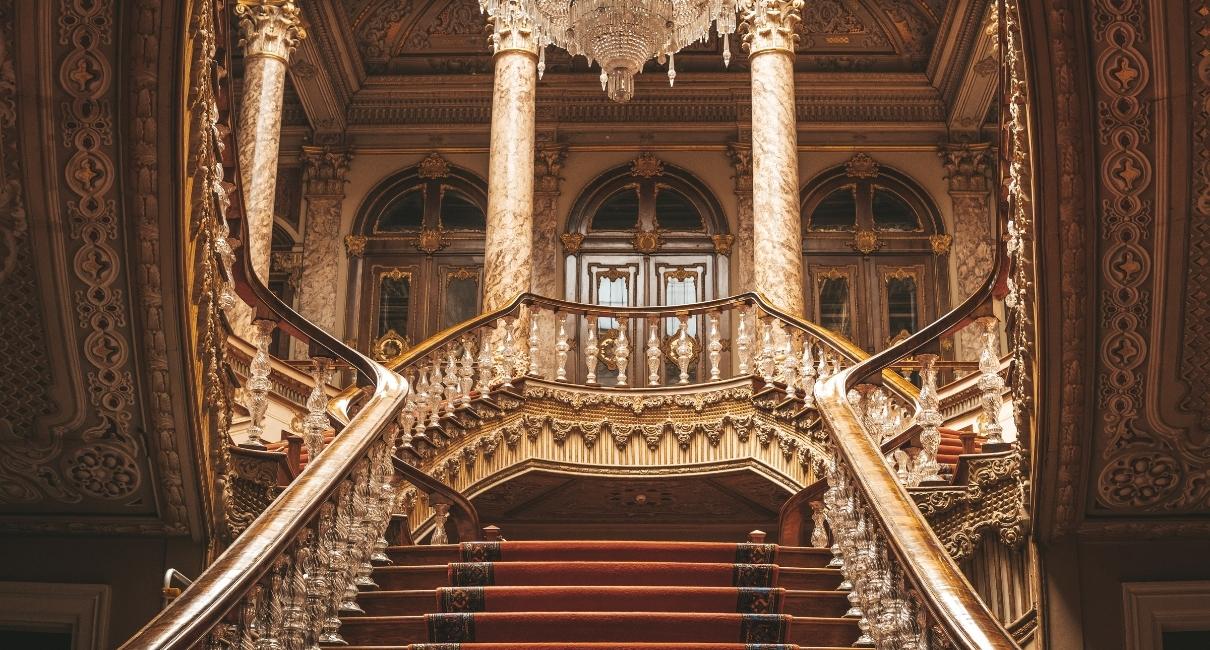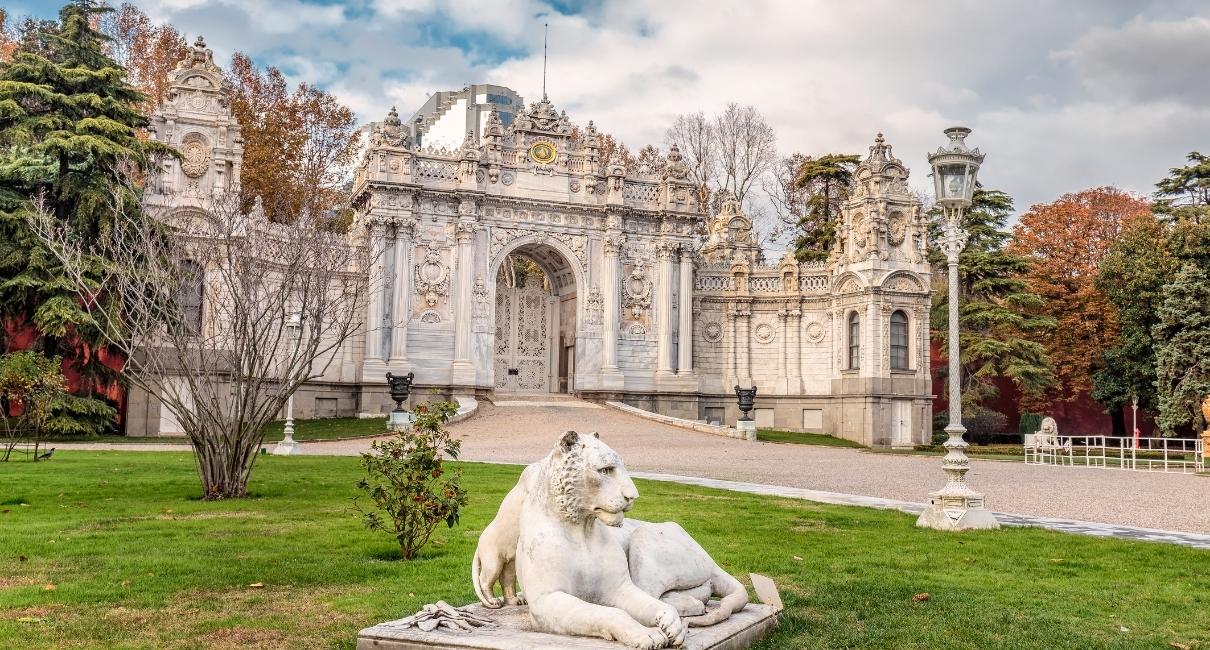Dolmabahçe Palace, a grand symbol of the Ottoman Empire’s might and Westernization, stands majestically on the Bosphorus shores in Istanbul, Turkey. Constructed between 1843 and 1856 by Sultan Abdülmecid I, this opulent palace marked Istanbul’s first European-style palace. Built on the site of a former Ottoman palace and imperial gardens, Dolmabahçe cost the equivalent of around 35 tons of gold.
Dolmabahçe Palace’s architecture is a magnificent blend of traditional Ottoman and European baroque styles, symbolizing a pivotal shift in Ottoman aesthetic preferences. The palace’s extensive use of Baccarat crystal, Bohemian crystal, and Hereke carpets in its interiors not only reflects the opulence of the era but also the Empire’s connections with the West. Each room and hall in the palace tells a story, intricately linking the grandeur of the Ottoman past with modern Turkish history.
Content Suggestion: Uncovering The Jewel Of Istanbul: Topkapi Palace
Visiting Dolmabahçe Palace offers more than just a glimpse into history; it’s an immersive journey through the heart of Turkish culture and heritage.
Practical Tips for Visitors
Planning your visit to Dolmabahçe Palace is crucial, especially during peak tourist seasons, to avoid long queues. Booking tickets online is recommended. Comfortable footwear is essential, given the extensive grounds and gardens to explore. Visitors should dress modestly, respecting the site’s cultural significance.
The palace’s interior boasts 285 rooms, 44 halls, 6 Turkish baths, and 68 toilets. Notable features include the Crystal Staircase, made of Baccarat crystal, brass, and mahogany, and a 4-ton Bohemian crystal chandelier in the ballroom-cum-throne room. The palace served as home to six sultans and was the death place of Kemal Atatürk, the founder of the Turkish Republic. Since 1984, it has operated as a museum showcasing artifacts, paintings, and historical items from the Ottoman era.

Visiting Dolmabahçe Palace offers a unique opportunity to immerse in Istanbul’s history and culture. The best times for a visit are during spring and autumn, from April to May and September to November, when the weather is more accommodating, and the crowds are smaller. At least two hours should be allocated for a comprehensive exploration, though those with a keen interest in Turkish history and architecture might wish to spend more time.
Dolmabahçe Palace Historical Background
Dolmabahçe Palace, a masterpiece of 19th-century architecture, marks a significant era in Ottoman history. Built under Sultan Abdülmecid I’s reign, it represented a shift from traditional Ottoman architecture towards European styles, signifying the empire’s modernization efforts. The palace, an embodiment of luxury and sophistication, was a political statement, showcasing the empire’s desire to align with contemporary Western powers.
Dolmabahçe was not just a residence for sultans; it played a crucial role in hosting important diplomatic meetings and events, thus serving as a bridge between the East and West during a time of significant political and cultural transformation in the Ottoman Empire.

Frequently Asked Questions (FAQs)
Here are answers to some frequently asked questions about Dolmabahçe Palace:
What is Dolmabahçe Palace?
Dolmabahçe Palace is a historical and cultural landmark in Istanbul, Turkey, built during the 19th century Ottoman Empire as the main administrative center of the government. It overlooks the Bosphorus Strait.
Why is Dolmabahçe Palace famous?
The palace is famous for its opulence and architectural splendor, blending European Baroque and Ottoman styles. It features lavish interiors with intricate detailing, crystal chandeliers, and grand rooms.
How to get to Dolmabahçe Palace?
You can reach the palace by bus (number 40 or 42T from Taksim Square), tram (T1 tram from Sultanahmet to Kabatas), or ferry (from Eminonu, Karakoy, and Besiktas to Kabatas).
What is the Dolmabahçe Palace Istanbul Entry fee?
The entrance fee ranges between 600 to 900 Turkish Lira, varying by day and time. The fee includes access to the main building, Harem rooms, and the painting museum.
Who built Dolmabahçe Palace?
Sultan Abdulmecid I commissioned the palace, and architects Garabet Balyan and his son Nikogos Balyan designed it. Construction began in 1843 and took 13 years.
Is Dolmabahçe Palace free?
No, visitors need to purchase a ticket. The cost varies depending on the tour type and access to the Harem section.
How to get to Dolmabahçe Palace from Sultanahmet?
Take the T1 tram to Kabatas and then walk or take a bus. Alternatively, a taxi or private tour is an option.
Is Dolmabahçe Palace worth seeing?
Absolutely. It’s a stunning example of Ottoman and European architecture with a fascinating history and cultural significance.
Can I buy Dolmabahçe Palace tickets online?
Yes, it’s advisable to purchase tickets online in advance for a seamless experience.
Who lived in Dolmabahçe Palace?
It was the residence of Ottoman Sultans from 1856 to 1922 and later the presidential palace of the Turkish Republic.
What can I do at Dolmabahçe Palace?
Explore its grand halls, lavish interiors, and Dolmabahçe Gardens for stunning Bosphorus views.
Is there an audio guide to visit Dolmabahçe Palace?
Yes, available in several languages, providing detailed information about the palace’s history and significance.
What is the Crystal Pavilion in the Palace?
The Crystal Pavilion, built in 1871, was a gift from the Empress Eugenie of France, used today for official receptions and ceremonies.

